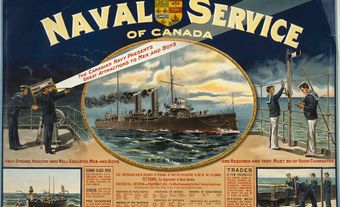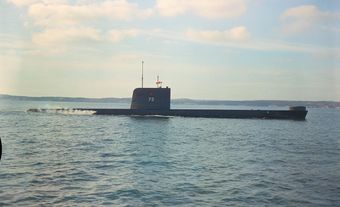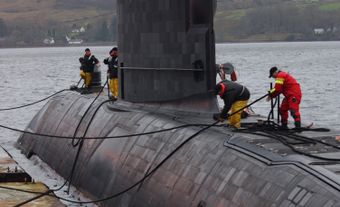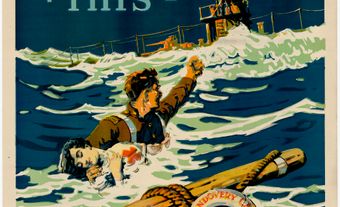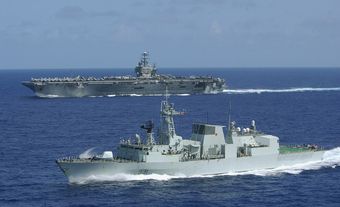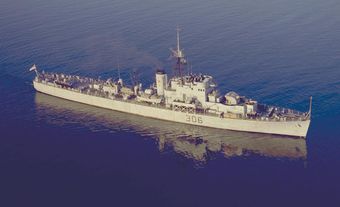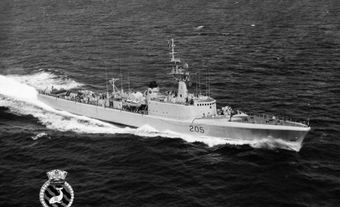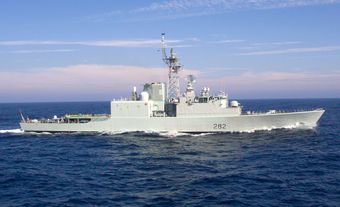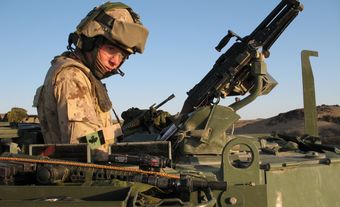The Victoria class are diesel-electric powered conventional attack submarines, referred to as SSK submarines. The Royal Canadian Navy (RCN) acquired four surplus Victoria-class submarines from the United Kingdom’s Royal Navy (RN) in the late-1990s. They were procured as a supposedly cost-effective interim measure to maintain a submarine capability for the RCN pending a permanent replacement for its three Oberon-class submarines. Following a troubled decade-long introduction process, the Victoria class eventually achieved full operational status. The Victoria-class submarines are intended to remain in service until a replacement projected for the late 2030s.
Did You Know?
Navies use a classification system to identify different types of submarines. NATO terminology for submarine classification is as follows: SS=subsurface; B=ballistic; K=hunter-killer; N=nuclear-powered. Together, these abbreviations describe submarines and their capabilities. SSK, for example, refers to a conventional (diesel)-powered, hunter-killer or attack submarine. SSN refers to a nuclear-powered submarine. SSBN refers to a nuclear-powered, ballistic-missile-carrying submarine.
Type 2400 Upholder-class Submarines
The RN undertook design of the Type 2400 Upholder-class submarines in the early 1980s. (The name Type 2400 denotes a submerged displacement of 2,400 tonnes). These submarines were a conventional replacement for the RN’s Oberon-class submarines. The Upholder class supplemented the otherwise primarily nuclear-powered attack submarine (SSN) fleet. Aside from the power plant, the 2400s had similar structural, sensor and weapon systems to the SSNs. But being non-nuclear and consequently shorter ranged, the 2400s conducted antisubmarine warfare patrols in the strategic Greenland-Iceland-United Kingdom (GIUK) Gap, working in tandem with SOSUS (Sound Surveillance System) against Soviet submarines. (See Canada and SOSUS and Canada and Antisubmarine Warfare during the Cold War.)
A class of twelve was planned, but in the end only four were built: Upholder, Unseen, Ursula and Unicorn. Construction on the lead vessel – Upholder – began in November 1983 and the submarine was commissioned in June 1990. Before the last one (Unicorn) could enter service, a post-Cold War British defence review determined the RN should shift to an all-nuclear submarine force. The submarines were declared surplus and taken out of service in 1994. Subsequent attempts to sell the four vessels to Pakistan, Portugal and Chile came into conflict with United States Navy (USN) defence technology sharing restrictions. Britain faced limited options elsewhere.
Victoria-class Acquisition and Canadianization
In Canada, meanwhile, a plan to replace its own three Oberons with an SSN force also had died with the Cold War. (See Canada and the Cold War.) As a member of the “Five Eyes” defence intelligence sharing community (Australia-Canada-New Zealand-United Kingdom-United States, or AUSCANZUKUS), the RCN qualified for technology transfers. The federal government’s 1994 White Paper on Defence announced the intention to explore the purchase of the Upholder class. This was an “interim” solution to retaining a submarine capability pending definition of a formal SSK replacement project. During the four-year long negotiation process, the RN maintained the Upholders in a non-active status. Finally in April 1998 an agreement was announced to acquire the four submarines for $750 million CAD (a significant discount on the potential cost to build a replacement).
The transfer entailed the submarines undergoing a “reactivation work period” (meaning they were placed back in active operational service) paid by the RN. This was followed by safety trials and diving qualification in Britain by Canadian crews. The transfer culminated in an acceptance and renaming ceremony before sailing for Canada, where a further “Canadianization” work period was conducted. This incorporated exchanging British sensor and weapons systems with Canadian ones that mostly had been fitted in the Oberons through the 1980s and were still in good condition. It also included replacing the RN Mk 24 Tigerfish torpedoes with USN Mk 48 heavy-weight torpedoes and fire control system. Additionally, Canadianization involved using the Canadian Towed Array Sonar (CANTASS) and various communications and periscope equipment fits.
The reactivation work in both Britain and Canada turned out to be much more of a challenge than anticipated. The vessels had not fully completed their introduction into RN service before being declared surplus. The complexity of submarine structural technologies was also new to Canadian industry. Additionally, other demands on the RCN budget were not forecasted, such as the major post-9/11 deployment of practically the entire surface fleet to the Arabian Sea theatre of operations. (See 9/11 and Canada.)
The final acquisitions were accomplished in sequence: Unseen was accepted and renamed Victoria, and commissioned in Halifax on 2 December 2000; Unicorn became Windsor, and was commissioned on 4 October 2003; and Ursula became Corner Brook, and was commissioned on 21 February 2003. The transfer of the final vessel, the original lead ship Upholder, re-named Chicoutimi, however, was struck with tragedy. The day after sailing from Britain for Canada, while travelling on the surface during a gale (strong wind) on 5 October 2004, sea water entered through the conning tower causing an explosion and fire that killed one officer and injured nine sailors, and left the submarine dead in the water. (See Chicoutimi Submarine Fire.) After being rescued, the badly damaged Chicoutimi was transported by heavy lift vessel, first to Halifax in January 2005 for a lengthy damage assessment, and then on to Esquimalt in April 2009 to undergo a major refit. Chicoutimi was finally commissioned in Esquimalt on 3 September 2015.
Employment
In June 2005, Windsor commenced the first operational cycle for the Victoria class, participating in a number of international exercises, including the successful tracking of a USN SSN and assisting in the work-ups (deployment preparation) of a USN carrier battle group. In the spring of 2007, Corner Brook participated in NATO exercise Noble Warrior, marking the first time in 15 years that a Canadian submarine had been present in European waters. In August later that year, Corner Brook deployed to the Arctic in support of Operation Nanook conducted by the Canadian Armed Forces. In March 2012, Victoria was declared fully operational following weapons certification. Soon thereafter it became the first RCN submarine to fire a live Mk 48 torpedo, sinking the former USS Concord on 17 July 2012 during a Rim of the Pacific (RIMPAC) exercise near Hawaii. In 2015 Windsor achieved the original ambition for the Upholder class in tracking a Russian submarine while patrolling the GIUK Gap. Chicoutimi deployed to the Far East in 2017-18 for an epic 197 days at sea, as part of Operation Neon enforcing United Nations sanctions against North Korea.
Life Extension and Replacement
In April 2015, the Conservative government of Prime Minister Stephen Harper announced plans for a major life extension for the class. This was confirmed in the Justin Trudeau Liberal government’s 2016 defence policy statement, Strong, Secure, Engaged. In the summer of 2021, the RCN set up a team to begin the Canadian Patrol Submarine Project with the aim to have a formal replacement of the Victorias complete in the late-2030s.

 Share on Facebook
Share on Facebook Share on X
Share on X Share by Email
Share by Email Share on Google Classroom
Share on Google Classroom












